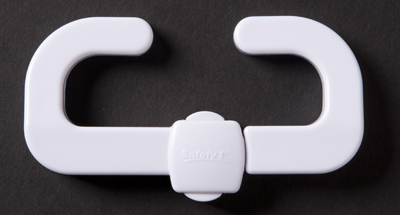Children younger than 5 represent nearly 75% of pool and spa deaths, the latest U.S. Consumer Product Safety Commission data shows. African-American and Hispanic children are at high risk. CPSC held a media event and Twitter chat on May 24, 2012, to promote water safety.
|
|||||
|
This address for this post is: http://www.cpsc.gov/onsafety/2012/05/poolsafely-drowning-is-leading-cause-of-child-deaths/ Regular readers of our blog may remember this child safety lock recall from March. Today, Dorel Juvenile Group is recalling two additional types of Safety 1st locks. The newly recalled locks are Safety 1st cabinet slide locks and toilet locks. They look like this:
Dorel Juvenile Group (DJG), the company that makes these locks, has received 278 reports of cabinet locks and 110 reports of toilet locks that did not adequately secure cabinets and toilets. In one reported incident, a 13-month-old swallowed small, toxic beads from a craft kit. You can find detailed information on how to identify the recalled locks here. The cabinet locks were sold at Bed, Bath and Beyond, Great Beginnings, Home Depot, Target, and Walmart from January 2005 through April 2010. The toilet locks were sold at the same stores from January 2000 through March 2009. Both locks were also sold on Amazon.com through April 2012. If you have these locks, don’t rely on them to keep children out of cabinets and toilets. Contact DJG at www.djgusa.com or toll-free at (877) 416-8105 between 8 a.m. and 5 p.m. ET Monday through Friday for a free replacement lock. While you are waiting for free replacement locks for cabinets, immediately store dangerous items out of reach of children. While waiting for a replacement toilet lid lock, keep the lid down to prevent access and consider placing a latch on the bathroom door that is out of reach of young children. This address for this post is: http://www.cpsc.gov/onsafety/2012/05/check-your-cabinet-and-toilet-locks/ Mira las chaquetas, las sudaderas y los suéteres de tus hijos. ¿No notas nada inusual? Ahora, mira de nuevo. ¿Tienen cordones? Por las razones mencionadas a continuación, la CPSC emitió una regulación en julio de 2011 que cataloga como un producto peligroso a la mayoría de los cordones en la ropa de abrigo infantil para la parte superior del cuerpo. Lo cual significa que no deberías encontrar a la venta, y que tus hijos no deberían usar, chaquetas, sudaderas y suéteres con cordones peligrosos. En otras palabras, las prendas de abrigo infantil entre las tallas 2T y 12 o S y L no deben tener cordones en el cuello o capucha. También son considerados peligrosos ciertos cordones en la cintura o parte inferior. Verifica lo siguiente con los cordones de cintura:  Los cordones en la cintura de esta prenda y los cordones en la capucha de la prenda de arriba no deberían ser parte de la ropa de tus hijos.
El siguiente es el motivo: Los cordones pueden enredarse en los juegos de recreo o en las puertas de un vehículo. La CPSC ha recibido 26 informes de niños que murieron cuando el cordón de su ropa se enredó en toboganes en un parque infantil, puertas del autobús escolar y otros objetos. Los cordones en la cintura y la parte inferior de la vestimenta que se atoraron en puertas u otras partes de autos resultaron en incidentes de arrastramiento. En febrero de 1996, la CPSC emitió directrices, que fueron incorporadas a un estándar voluntario en 1997. A partir de que la industria comenzó a implementar el estándar, las muertes que involucran vestimenta con cordones en cuellos o capuchas disminuyeron en un 75 por ciento, y no ha habido muertes asociadas a cordones en la cintura o parte inferior de las prendas de vestir. Aun así, se siguen descubriendo chaquetas, sudaderas y suéteres con cordones peligrosos. La CPSC ha anunciado más de 130 retiros del mercado de prendas con cordones, incluyendo 8 retiros en los pasados seis meses. Aquí están los del último mes. Por tanto, verifica la ropa de abrigo de tu hijo y sigue las instrucciones mencionadas en cada retiro. This address for this post is: http://www.cpsc.gov/onsafety/2012/05/los-cordones-no-estan-permitidos/ Look at your child’s jackets, sweatshirts and sweaters. See nothing unusual? Now, look again. Do they have drawstrings?
For reasons we show below, CPSC passed a rule in July 2011, designating most drawstrings in children’s upper outerwear as hazardous. This essentially means that you shouldn’t see for sale, and your child shouldn’t wear, jackets, sweatshirts and sweaters with dangerous drawstrings. That means no neck or hood drawstrings for upper outerwear in sizes 2T through 12 or S through L. In addition, certain waist or bottom drawstrings are considered dangerous.  These waist drawstrings and the hood drawstrings above are what you should not see on your child’s clothes. With waist drawstrings, there are three things to look for:
Here’s why: Drawstrings can catch on items such as playground equipment or vehicle doors. CPSC has received 26 reports of children who have died when drawstrings in their clothes got tangled on playground slides, school bus doors and other objects. Waist and bottom drawstrings that were caught in cars and buses resulted in dragging incidents. CPSC first issued guidelines on drawstrings in February 1996. These were then incorporated into a voluntary standard in 1997. Since the clothing industry started following the voluntary standard, deaths involving neck or hood drawstrings decreased by 75 percent and there have been no deaths associated with waist or bottom drawstrings. Still, we continue to see jackets, sweatshirts, and sweaters made with drawstrings that are dangerous. CPSC has issued more than 130 recalls involving clothes with drawstrings including 8 recalls between November 2011 and May 8, 2012. Here are some recalls from just the past month (as of publication of this blog). So, check your child’s upper outerwear and make sure to follow the instructions on these recalls. This address for this post is: http://www.cpsc.gov/onsafety/2012/05/drawstrings-not-allowed/ |
|||||
|
Privacy, Security, and Legal Notice | Accessibility Policy | Open Government @ CPSC| Contact Us |
|||||












